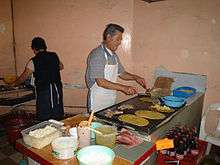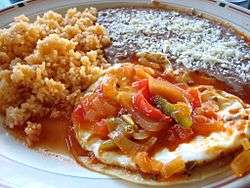Huarache (food)
Huarache (sometimes spelled guarache; [waˈɾatʃe] (![]()
A huarache with chicken and red salsa, in Mexico City | |
| Type | antojito |
|---|---|
| Place of origin | Distrito Federal, Mexico |
| Main ingredients | corn dough, refried beans, nopalitos, meat, cheese, lettuce, onions, red or green sauce (salsa) |

The name "Huarache" is derived from the shape of the masa, similar to the popular sandals of the same name. The word Huarache is originally from Purépecha[3] and the Nahuatl word for huarache is kwarachi. Huaraches are similar to sopes and tlacoyos but differ in shape.
Origin
Huaraches originated in Mexico City in about the early 1930s. Their origin was at a stall along La Viga navigation channel, where Mrs. Carmen Gomez Medina prepared tlacoyos.[4] When the navigation channel was covered to make the "Calzada de la Viga", Mrs. Gomez moved to another place and after 1957, when the Mercado de Jamaica was founded, she moved there, and then to a little place at Torno street. Because Mrs. Gomez's new invention was shaped differently than a sope or a tlacoyo, people started to call it "huarache".
See also
- List of Mexican dishes

References
- "Archived copy". Archived from the original on 2008-12-29. Retrieved 2010-08-05.CS1 maint: archived copy as title (link)
- "EL HUARACHE AZTECA". www.elhuaracheazteca.com. Retrieved 2017-05-04.
- "Familia tarasca - SIL México". www.sil.org.
- Robb Walsh "Historic Huaraches in Stafford"Houston Press. July 01, 2008.
| Wikimedia Commons has media related to Huaraches (food). |


.jpg)
